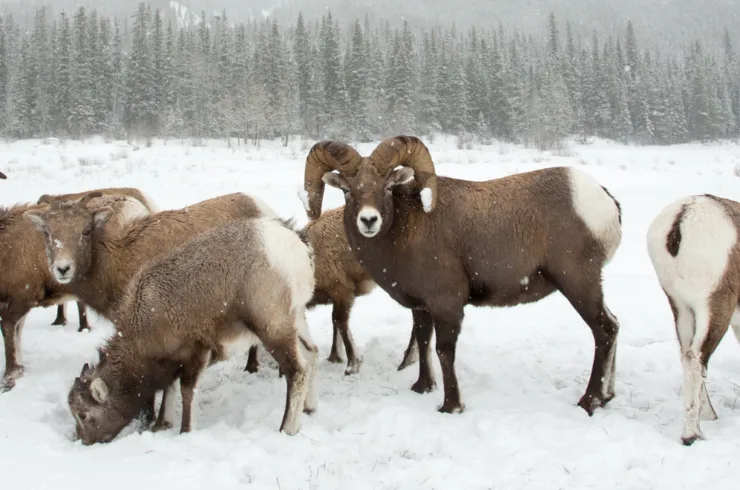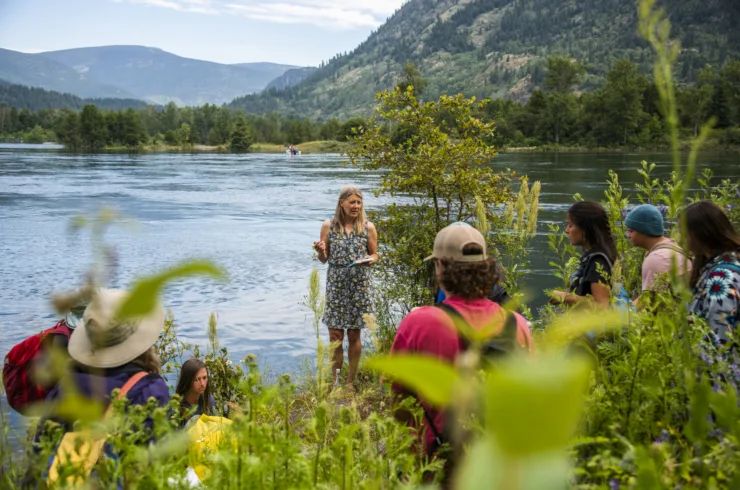In southwestern Alberta, one unassuming wetland downstream of an abandoned coal mine has been silently removing dangerous pollution for decades. Could it hold answers for British Columbia’s Elk Valley?
In 1983, the Tent Mountain coal mine, just east of the B.C.-Alberta border, ceased operations after more than three decades of open-cut mining. The site was never reclaimed, leaving a gaping pit and piles of waste rock open to the elements. More than four decades later1, weathering of that waste rock continues to leach naturally-occurring pollutants into nearby waters.
Those pollutants come in many forms, but the levels of one in particular are cause for great concern. Selenium is essential to life in small amounts; in higher doses, however, it quickly becomes toxic, especially in aquatic ecosystems where it can build up in the food chain over time, leading to major reproductive failures in top predators like trout.
At a small pond directly below the Tent Mountain mine’s waste rock piles, researchers have recorded selenium levels up to 90 times higher than what’s considered safe for aquatic life. Normally, those concentrations would likely have catastrophic consequences for native fish populations, but just downstream of the mine site, a natural 29-hectare wetland is quietly performing a remarkable ecological clean-up.

Wetlands as natural water filtration systems
Wetlands are some of our most biodiverse ecosystems — it’s estimated that 40% of the world’s biodiversity can be found in wetlands. In addition, they’re valued for the wide array of ecological services they perform, from lessening the impact of floods and droughts, to sequestering carbon from the atmosphere and storing it as rich soil. But they can also serve a lesser-known role cleaning up water-based pollution.
At the wetland downstream of Tent Mountain, plants like cattails and duckweed are absorbing selenium from the water and either storing it in the soil in a safer, more inert form2, or releasing it harmlessly into the atmosphere. Based on readings above and below the wetland, it appears to be removing about half of the selenium released by the mine3.
This feat is all the more astounding given the huge amount of money and time being spent across the provincial border to build and operate facilities to deal with decades of waste rock accumulation and selenium leaching.


Water woes in the Elk Valley
In B.C.’s Elk Valley, selenium pollution from Elk Valley Resources’ coal mines has led to estimates that more than half of all fish may have failed to be born or survive to adulthood due to selenium-related impacts in the most heavily impacted waterways4.
The cost of cleaning up this pollution is staggering. Teck Resources’ short-term water treatment plan for their Elk Valley mines alone came out to $6.4 billion. Keep in mind this plan would not even be enough to return selenium concentrations to natural baseline levels.
Already, billions of dollars have been sunk into industrial water treatment facilities. And while those facilities are effective, there is far more contaminated water in the watershed than they’re capable of treating. In 2022, an independent report estimated that EVR’s water treatment facilities removed just under 20% of the total selenium load caused by decades of open pit mining, leaving over 80% to flow downstream. Additional treatment capacity has been added since then, but not enough to bring selenium concentrations below natural baseline levels.
Given what we’ve seen occur at the Tent Mountain mine site, the construction of wetlands downstream of the Elk Valley mines could function as an adjunct to treatment facilities, adding biodiversity value and increasing ecosystem resilience — all while helping to manage the enormous pollution problem that industry has produced.

Are coal mines as economically beneficial as we think?
In B.C., and across the world, industry and many governments continue to tout the economic benefits of coal mining, despite the environmental costs. Coal remains B.C.’s largest source of mining revenue, with $10.6 billion dollars worth of coal produced in 2023 (copper came in a distant second at $3.2 billion5).
New mines and mine expansions continue to make headlines, with ongoing progress on both Crown Mountain and the enormous Fording River Extension projects on the B.C. side, as well as Grassy Mountain across the border in Alberta.
But research suggests the historically stated economic benefits of coal mining are often far overblown; coal mines in northeast B.C. were shown to have produced only 64% of the jobs they claimed they would, and a paltry 34% of their projected tax revenue6. The economic benefits that remain tend to evaporate rather quickly when you take into account the long-term remediation, monitoring and water treatment that will be necessary to ensure clean water for the future.


A generational problem
Abandoned mines continue to cause enormous environmental problems decades after closure, the full breadth of which we are just beginning to understand. Compared to the enormous mines spread throughout the Elk Valley, the Tent Mountain mine was a relatively small operation — and, as we’ve learned, it came with a wetland that’s been removing half of all selenium from the system — but it’s still heavily impacting downstream fish populations.
Recent studies have found that fish in Crowsnest Lake have selenium concentrations in their organs 2-4 times higher than Alberta’s safety guidelines. Lake trout fare even worse, with almost 10 times more selenium than identical fish in an unimpacted lake7. It should be noted that selenium levels within the water of Crowsnest Lake meet Alberta’s selenium water quality safety guidelines, which are identical to B.C.’s. Unhealthy fish found in a lake that meets water safety guidelines should be ringing major alarm bells, both in Alberta and in BC.
Eighty-five percent of fish fingerlings examined in the Crowsnest River exhibited clinical signs consistent with either whirling disease or selenium poisoning, which tend to express themselves similarly in juvenile fish8.
These fish are all being impacted by coal mining that ceased in the 1980s. Given that the Elk Valley mines are not only still operating, but expanding, we can likely expect to see long-term selenium impacts in the watershed at an unprecedented scale.

A dual approach
It is long past time to have a clear-headed look at the future of coal and the risks of allowing expansions to occur on mine complexes that already take up nearly 17,000 hectares — 1.5 times larger than the city of Vancouver.
Looking closer at the long term generational impacts puts into perspective that these coal mines are gambles. Not only are we risking the health of all downstream aquatic ecosystems, but we are sacrificing the health of water that our descendants will need to drink for decades or even centuries into the future, all for short-term economic gain.
Wetlands offer a promising path to minimizing some of the damage, but nature can only absorb so much. New coal projects continue to move forward, and old mines leach dangerous pollutants with no end in sight, raising questions about whether the short-term economic returns are worth the irreversible ecological and human health costs, let alone the long-term financial liabilities when decades or centuries of necessary water treatment enter the equation. The science is clear: wetlands deserve our protection and could provide much needed improvements to water quality, and our mining policies demand a serious, systemic rethink.
- https://www.sciencedirect.com/science/article/pii/S0269749124000423
- https://apms.org/wp-content/uploads/japm-39-01-033.pdf
- https://www.sciencedirect.com/science/article/pii/S0269749124000423
- https://wildsight.ca/wp-content/uploads/2019/04/2014-Water-review_environment_canada_lemly.pdf?x67982
- https://www2.gov.bc.ca/assets/gov/farming-natural-resources-and-industry/mineral-exploration-mining/documents/health-and-safety/ci-annual-reports/2023-24_cim-cpo_report_publish.pdf
- https://www.sciencedirect.com/science/article/abs/pii/S0195925523000409
- https://www.biorxiv.org/content/10.1101/2025.05.22.655156v1.full.pdf
- https://cdnsciencepub.com/doi/10.1139/cjfas-2020-0484







